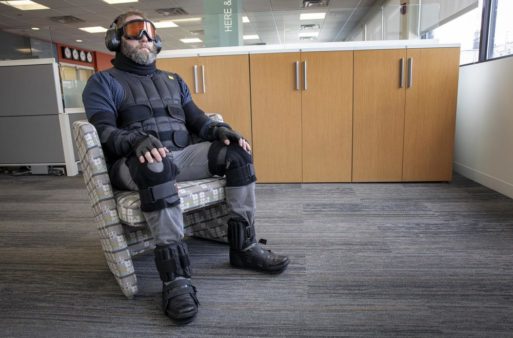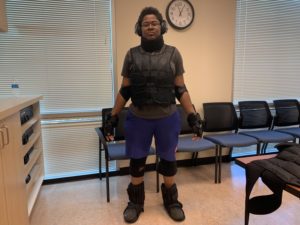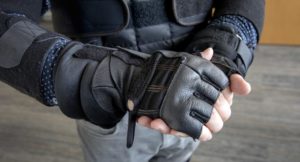
Credit: wbur.org
There are countless ways in which new inventions and technology have transformed our understanding of the aging process. One such advancement is the so-called GERT suit. (GERT is short for gerontology, the scientific study of aging.) It’s used mainly by medical schools and engineering and development firms to teach its users about the physical subtleties of aging.
Vision-altering goggles, weighted Velcro attachments on the hands, arms, legs and feet as well as muted earmuffs all combine to alter the user’s senses. This, in turn, causes participants to forge a more empathetic understanding of what it’s like to live as an elderly individual.
This is reminiscent of the Virtual Dementia Tour SevenPonds wrote about last year. The Virtual Dementia Tour (as the name suggests) is meant for caregivers to understand the symptoms of dementia more than the normal aging process. However, it seems that understanding aging and its nuances has become a very useful tool for both developing new technologies and ways we interact with our older citizens.
Medical School Use
One of the best ways a GERT suit can be useful is in the medical school realm. Teaching up-and-coming doctors the ways in which their patients may be suffering can beget a greater sense of compassion and empathy — something we need in this age of intense computerization in the medical world.

A patient actor wearing
a GERT suit at A.T. Still University.
Credit: kjzz.org
A.T. Still University in Mesa, Arizona, uses GERT suits for this exact reason. Students in the university’s osteopathic program use the suits to better gauge the ways their older patients may be ailing.
“I think today’s patients want a connection with their doctors,” said Lorree Ratto, an associate professor at A.T. Still who directs the school’s simulation center. “In this kind of technology world, where doctors hide behind computers…[patients have] lost that connection with their doctors.”
A few years ago, Ratto had her students spend time in wheelchairs in an attempt to help them empathize with patients who may have a disability. But she found that students would wind up using the chairs to do wheelies in the parking lot and goof around. A GERT suit forces the user to experience the symptoms; there’s no way to ignore what you’re wearing and what’s attached. The university plans to expand GERT suit usage to other disciplines such as the occupational and physical therapy programs.
Architectural and Engineering Use
Here & Now recently produced a story about Corgan, an architectural firm in Dallas. The company used GERT suits to simulate the ways older people may have difficulty moving around public spaces.
Two of Corgan’s designers wore the suits around the airport in Dallas. The goal was for the architects to gain a better understanding of and therefore deeper empathy for senior citizens. This, in turn, would enable them to design more-accessible building spaces for elderly folk.
“One of the things that we really took away from the staff that ran through the scenarios is that having the hearing and the sight losses is really isolating,” said Mike Steiner in the Here & Now story. “So even though I was at the airport [and] I did not have a flight to catch, I couldn’t understand half of the announcements. The losses that you have can be a little bit overwhelming.”

The GERT suit’s weighted wrist and glove
attachments alter user’s dexterity
Credit: wbur.org
One of the architects that took part in the exercise, Samantha Flores, noted that most airports have large, open concourses that enable high-volume areas to accommodate massive crowds. However, this can be very difficult to maneuver through for someone with limited mobility.
“The first thing that I noticed is that it takes a longer time to get to different places,” said Flores, “and so the need to rest and to sit is very impactful: Have more benches, have more places for someone to grab on to.”
The Impact of Empathy
Being able to understand the difficulties and physical limitations aging brings to people is vital if we are to better integrate the elderly into our everyday lives. It is hard to understand someone’s life if we’ve never experienced something similar.
For instance, it might be frustrating for a young person walking with their grandparent to rest with them often. That idea may not even cross an architect’s mind when designing a public space. Or a doctor might have a tough time really understanding a patient’s frustration when the doctor’s suggestions don’t work for them.
Technological advances like the GERT suit can certainly aid younger people in developing empathy for our senior population. Although GERT suits aren’t readily available for the general public (they’re made in Germany and can cost around $5,000), they are definitely one way for certain professionals to better understand the nuances or aging.

 GERT Suit Helps Users Understand Nuances of Aging
GERT Suit Helps Users Understand Nuances of Aging



 “I Will Remember You” by Sarah McLachlan
“I Will Remember You” by Sarah McLachlan
 Greenland Sharks May Offer Clues to Extending Human Lifespans
Greenland Sharks May Offer Clues to Extending Human Lifespans














